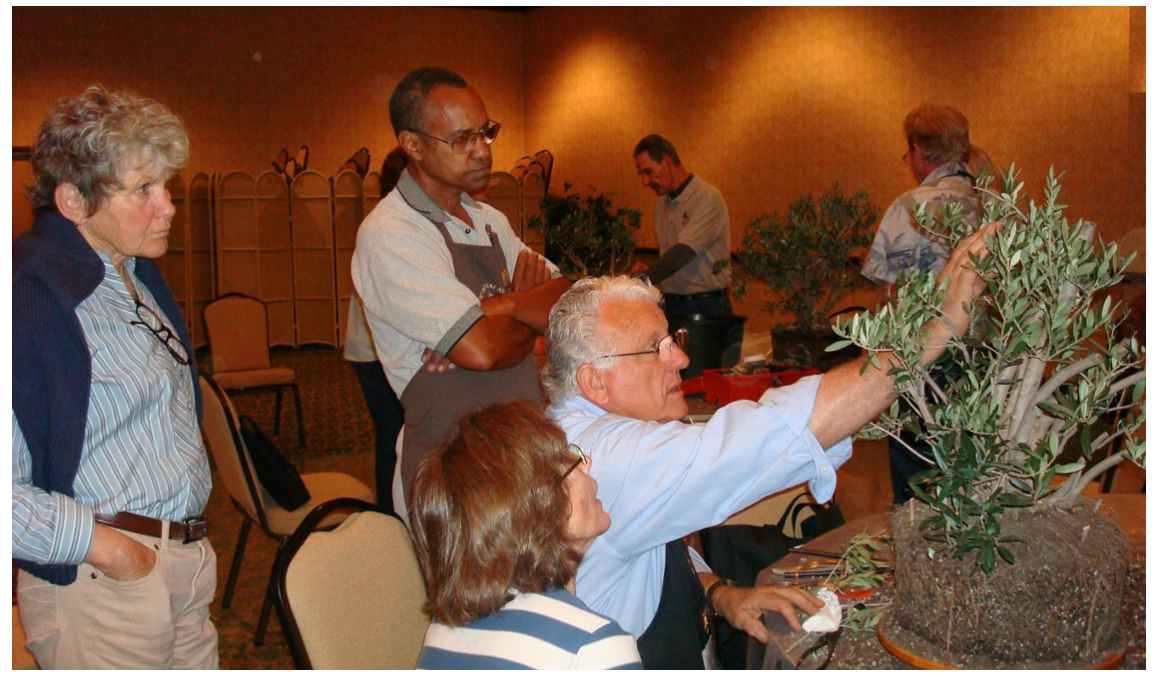Warren Hill at his one-man show at East Tennessee State University in the late 1990s. Trees (from left to right): American Hornbeam, Bald Cypress and Ginkgo Biloba, also known as Chi Chi Ginkgo.
Warren Hill, a renowned figure in the art of bonsai, recently passed away at his home in Tennessee at the age of 85. His life story is one of passion for bonsai, dedication to his family, and a love for nature.
Born in Minneapolis, Minnesota in 1938, Warren was industrious from a young age. At six, he would shine shoes for soldiers and sailors at the U.S. Navy Yard, and at 16, he painted Walt Disney’s apartment at Disneyland prior to the park’s opening. While Warren was painting, Mr. Disney walked in and surprised him. They started a conversation, and Mr. Disney thanked him for doing a good job.
Following high school, Warren served as a radar technician in the U.S. Air Force. After military service, he pursued a career as an electrical engineer with Westinghouse and later Edison International. Meanwhile, he developed a passion for photography, and throughout his life he would often capture landscapes with family and friends.
Warren served as the curator of the National Bonsai & Penjing Museum from 1996 to 2001. He had a deep interest in Japanese culture that developed from an early fascination with the natural world, which he inherited from his parents. His Finnish father and Swedish mother, who had a talent for gardening, instilled in him a love for flora and fauna. This background, along with his college studies in engineering and horticulture, laid the foundation for lifelong bonsai endeavors.
Left: Warren works on a black pine of Jack Fried, a former president of the Midwest Bonsai Society. Right: Warren helps a student at a bonsai workshop work on their Shimpaku Juniper. He traveled around the world to style trees at student workshops.
A transformative moment happened in his twenties, when Warren walked into an exhibition hosted by the California Bonsai Society in 1960. Although bonsai was not part of his upbringing or education, the exhibition immediately captivated him. “I didn’t know what I was looking at, but I knew it was magnificent,” he said. “I had to learn more about these little trees.” This chance encounter marked the beginning of a lifelong journey that would intertwine his personal and professional paths with the art of bonsai.
His passion quickly evolved from an interest to a vocation. By 1974, he was teaching bonsai, offering lectures, demonstrations, and workshops. He immersed himself in the art and philosophy, studying with masters like Saburo Kato, John Naka, and Frank Nagata. Warren later returned to Moorpark College to study agriculture, and by 1974, he was teaching bonsai through lectures, demonstrations, and workshops. He found striking similarities between his Scandinavian heritage and Japanese culture, especially in their reverence for art and nature.
Left: One of Warren Hill’s Satsuki Azalea in Informal upright-bunjin, propagated by cutting.
Right: One of his trident maples in the yose-ue style, propagated by seed.
In 1996, Warren was appointed Curator for the National Bonsai & Penjing Museum at the U.S. National Arboretum in Washington, D.C. “It was an honor to even be asked to be interviewed for the job,” Warren said. “It was a rich position, and I really enjoyed it.” His tenure was marked by fostering relationships with volunteers and nurturing the Museum’s bonsai collections.
Jack Sustic, another former Curator, served as Warren’s assistant. “He was always a teacher and a wealth of knowledge, and I still carry his teachings with me,” he said. “Those teachings helped improve my own bonsai artistry, for which I will always be grateful.”
Warren used his own drawings of different bonsai styles to show students an idea of what the style looks like. This is Chokkan, which has a formal upright trunk. The majestic appearance represents a large, tall tree standing in the mountains or on a vast low-land plain. Usually the tree's outline is in a pyramidal form.
In his position as curator, Warren most appreciated the opportunity to meet and work with the Museum volunteers who help care for the masterpiece collections of bonsai.
“All those nice people loved the art as I did,” he said. “You meet so many talented people like them, and masters like Kato and Naka, who were all special and of exceptional quality. When you know the background of people like them and know how gifted they are, you’re kind of in awe when you’re around them.”
Warren at the California State Convention, holding a workshop for students in Anaheim, California. They are working with olive trees.
Warren’s personal life also flourished during this time. In 1998, he met Sharon Jeffers Hackett at a Rotary Club meeting in Greeneville, Tennessee. They married in 2000, and after his retirement in 2001, they moved back to Tennessee and established Tree-Haven, a bonsai school that attracted students worldwide. Warren loved teaching, saying, “I like watching the students’ eyes light up when you tell them the answer to a question.”
In recognition of his contributions, the Golden State Bonsai Federation awarded Warren the Circle of Sensei Award in 2013. Throughout his life, he believed that a deep love and passion for nature were essential for success in bonsai. Beyond his teaching, Warren authored numerous articles on bonsai and horticulture, ensuring that his legacy would inspire future generations. He leaves behind a rich heritage of bonsai artistry and a community of students and admirers who continue to honor his work.
Warren is survived by his wife Sharon, daughters Dawn and Lisa, grandchildren, step-children, and other family members. His life and work remain a testament to the spirit and philosophy of bonsai, continuing to inspire students and practitioners of the art form.
More on Warren:











